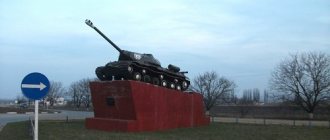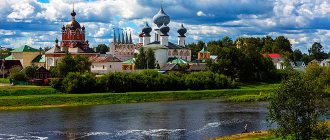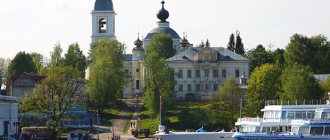Year founded: 1773
Tikhvin - City of Military Glory
Tikhvin
is a Russian city, an administrative district center in the Leningrad region, located on both banks of the Tikhvinka River (Lake Ladoga basin). The distance from the city to St. Petersburg is 236 km.
The name of the city was derived from the Tikhvin River (ancient Russian “quiet”), now it is the Tikhvinka River. Tikhvin began to be considered a city in 1773
, before that there was a Tikhvin churchyard here. Its development ensured its location at the crossroads of trade routes connecting the Volga with Ladoga and the Baltic Sea.
The city is famous for the miraculous Tikhvin Icon of the Mother of God, which, according to legend, miraculously appeared on the banks of the Tikhvinka River in 1383. Later, in 1560, by order of Tsar Ivan IV, the Mother of God Assumption Monastery was founded here, on the left bank of the Tikhvinka River. In the same year, the Tikhvin Vvedensky Convent was built. Both of these monasteries are still active today.
During the Great Patriotic War, Tikhvin was occupied by German troops. The command of Army Group North decided to strike through Tikhvin to Lodeynoye Pole, link up with Finnish troops on the Svir River and thereby completely blockade Leningrad. On November 8, 1941, the Germans captured the city, but Soviet troops managed to break the enemy. On December 9, 1941, as a result of the Tikhvin offensive operation, the city was liberated.
In 2010, Tikhvin was awarded the honorary title “City of Military Glory”.
Transfiguration Cathedral (Photo: wikipedia.org) The modern city of Tikhvin is divided into two parts: the Old Town, which is a provincial town, and the New Town - microdistricts with multi-storey buildings. The old town is mostly made of wood; in the central square there is the main temple of the city - the Transfiguration Cathedral. The new city consists of 10 residential neighborhoods.
In addition to temples, in Tikhvin you can visit the Vepsian Forest park, where you can learn about the life of the ancient people - the Vepsians, and the House-Museum of the composer Rimsky-Korsakov, a native of the city.
Tikhvin was also the birthplace of such cultural and artistic figures as director Sergei Grigoriev, painter Pyotr Zabolotsky, and Russian actor Nikolai Ivanov.
Day of the city
in Tikhvin it is celebrated in July.
Tikhvin - the city of military glory
One of the first major victories of the Soviet troops in the Great Patriotic War is associated with Tikhvin.In the very first days of the war, most men of military age left Tikhvin to join the Red Army, the People's Militia and the extermination battalion created in the city. In July, the formation of the 272nd Infantry Division began in the area of the village of Berezovik. On July 27, the fighters took the oath, during which city residents presented the Red Banner to their fellow countrymen.
On June 28, 1941, the evacuation of children from Leningrad to Tikhvin began. Numerous kindergartens for young Leningraders were additionally opened in the city.
Since September 1941, Tikhvin became a front-line city. The Tikhvin residents carried out large-scale defensive work: they dug anti-tank ditches, built pillboxes and bunkers. In August alone, 9 landing pads for aircraft were built. About a thousand people worked on construction.
Day and night, Tikhvin railway workers, despite the bombing, kept a combat watch. Instead of destroyed tracks, spare tracks were laid, on which trains with ammunition and food were formed for besieged Leningrad. The non-stop movement of the echelons was ensured even when the front line approached Tikhvin almost closely.
In October 1941, a network of eight underground Komsomol groups was formed in Tikhvin, and 6 partisan detachments were created. 18 partisans were awarded orders and medals for courage and heroism.
During the war, there were 55 medical institutions in the Tikhvin region. Tikhvin residents took a great part in their arrangement and care for the wounded.
Thousands of soldiers and officers fought near Tikhvin, 9 military personnel were awarded the title of Hero of the Soviet Union for their exploits in the battles for the city, 3 natives of the Tikhvin region were awarded this high title for their exploits on the fronts of the Great Patriotic War. 965 soldiers and commanders who fought near Tikhvin were awarded high military awards. 7 military units and formations of the Red Army were awarded the Order of the Red Banner for the Tikhvin operation.
The memory of the Great Patriotic War is immortalized in the names of 19 Tikhvin streets. 10 heroes were awarded the title “Honorary Citizen of the City of Tikhvin.”
The significance of the Battle of Tikhvin is difficult to overestimate. The fascist German command of Army Group North, trying to quickly capture Leningrad and having failed in attempts to storm it, decided to strike through Tikhvin to Lodeynoye Pole, connect with Finnish troops on the Svir River and thereby completely blockade Leningrad. For this purpose, the Nazi command concentrated in the area of Kirishi station the 39th mechanized corps, which was transferred from the west, consisting of 2 tank and 2 motorized divisions. This strike group was given the task of breaking through the small barriers of our 4th Army, capturing Tikhvin and subsequently reaching the Svir River to link up with Finnish troops.
At dawn on October 16, 1941, the Nazis went on the offensive. Despite the fierce resistance of the Soviet troops, the Nazis, thanks to their great numerical superiority, captured Tikhvin on November 8.
The fascists rejoiced: “Leningrad itself will raise its hands. He will fall sooner or later. No one will be able to break through the created lines,” Hitler said, speaking in Munich on the day of the capture of Tikhvin.
A grave threat loomed over Leningrad. The capture of Tikhvin meant the loss of the only route through which the city on the Neva was supplied with food, weapons and ammunition. And the nearest supply bases were now located 320 kilometers away, in the area of the small railway stations Zaborye and Podborovye.
The day after the fall of Tikhvin, the Headquarters of the Supreme Commander-in-Chief ordered General K. A. Meretskov to take command of the 4th Army, eliminate the enemy and provide railway communication in the Tikhvin-Budogoshch and Tikhvin-Volkhov sections.
In view of the exceptional importance of the task at hand, additional forces and resources from the Headquarters reserve were transferred to Meretskov’s disposal. Already by November 11, in certain sectors of the front, our units attacked the Germans in order to create conditions for the offensive, which was scheduled for November 19. Through stubborn battles, the Soviet troops bled the enemy dry, prevented him from reaching the Svir River and Lake Ladoga, and created the preconditions for launching a counteroffensive.
“No one could really explain how the city was surrendered”
After the breakthrough of German troops from the bridgeheads on the Volkhov and the capture of Budogoshcha and Malaya Vishera on October 23–24, 1941, the German command was going to build on their success. On October 28, 1941, the German offensive on Volkhov began, and things were going well for Army Group North. According to the order for the 16th Army, the main task of Rudolf Schmidt's XXXIX Corps was to cut the Volkhov-Tikhvin railway. The target of the troops of the entire 16th Army east of the Volkhov River was both of these cities.
Army commander's mistake
Units of the 12th Panzer Division of General Joseph Harpe rushed to Tikhvin, drowning in the mud. As of November 1, 1941, it was a real monster, bristling with hundreds of machine guns (there were more than 600 units in the division), mortars, anti-tank and battalion artillery. The division had a very strong artillery regiment and had 61 combat-ready tanks. The total number of personnel was at least 15,000 people.
Josef Harpe, commander of the 12th Panzer Division. alchetron.com
The Soviet command tried to stop the Germans. To prevent Kharpa, new troops were urgently transferred to the Tikhvin direction: weakly armed units of the 44th and 191st rifle divisions. In addition, they managed to bring a number of other forces into the area, which were supported only by T-26 tanks from the 60th Tank Division.
The right flank of the XXXIX Corps strike group got involved in heavy fighting with part of the forces transferred from the 54th Army and the 60th Tank Division. As a result, the German motorized infantry moved forward, but it was difficult for them to do so. A particularly fierce battle took place near the village of Sitomlya in the Tikhvin region. The commander of the 4th Army, Vsevolod Fedorovich Yakovlev, piecemeally threw the forces that had arrived in his army into battle. The Germans were detained, but they still defeated the attackers.
The situation for the Soviet command here, east of Leningrad, could not be called anything other than a crisis. Commander Yakovlev made many mistakes, and now they began to put pressure on him from above. At this time, the situation in the Moscow direction somewhat normalized, and the Supreme Command Headquarters, as well as Joseph Stalin personally, were able to pay attention to other sectors of the front. Yakovlev was once again demanded to organize a counterattack.
However, the army commander was unable to correctly assess the situation. He concentrated significant forces against the right flank of the shock group of the XXXIX Motorized Corps, where Colonel Hans Zorn's 20th Motorized Division was located. The 4th Guards Rifle Division, the relatively fresh 92nd Rifle Division, and the bulk of the 60th Tank Division's forces acted against it. On October 30, these troops, united in a task force, began to attack Hans Zorn's division. The Germans found themselves firmly tied up in the battle, and they even had to retreat. However, in the main direction, the enemy command strengthened the 12th Panzer Division and prepared it for the offensive. For several days, the Germans repulsed attack after attack, but this had little effect on their preparation: Yakovlev gathered too few forces to cope with a real monster in the form of a tank division, albeit a battered one.
Tikhvin captured
On November 1, Rudolf Schmidt signed the order to attack. The main blow to Tikhvin was to be delivered by the 12th Panzer Division. The 51st Infantry Regiment of the 18th Motorized Division was transferred to it. The motorized infantry of the 12th Panzer itself was already quite tired. This was especially true of the 25th Motorized Infantry Regiment. At the same time, one tank battalion of the 12th Panzer Division was transferred to the shock group of the I Army Corps, and another platoon was transferred to the 18th Motorized Division. So the striking force of the 12th Panzer Division now became the motorized infantry.
The start of the offensive was scheduled for November 7. Early in the morning, German artillery opened fire. Units of the 191st and 44th Rifle Divisions acted against the advancing units of the 12th Panzer Division. Judging by the enemy's data, he simply crushed the Soviet units with one blow and went forward. The seal of the headquarters of the artillery regiment of the 191st Infantry Division was lost in the battle.
Commander of the 191st Rifle Division Pavel Semenovich Vinogradov. en.wikipedia.org
The Germans weren’t just rushing towards Tikhvin. Even before the capture of the city, a specially formed group blew up the Volkhov-Tikhvin railway.
Yakovlev tried to do at least something. A Tikhvin defense headquarters was created and outposts were installed. The city was defended by a combined battalion of Major Gusev numbering up to 600 people. But the Soviet garrison no longer had time. Units of two divisions of the 4th Army were driven back and partially scattered. The enemy was literally two steps away. All measures taken for defense are already too late. According to some reports, units of the 191st Rifle Division were supposed to withdraw to the northern outskirts of Tikhvin, but this never happened. The Soviet rifle units were scattered, there was no organized defense, control was completely lost, and the German motorized infantry moved forward, encountering almost no resistance.
We can learn how the situation developed for the enemy from the history of the 5th Motorized Infantry Regiment. At about 19:00 on November 8, his 1st battalion was already at Tikhvin itself. The commander forbade his subordinates to open fire, hoping to capture the city with a quick blow. The motorized infantry took the Soviet units in Tikhvin by surprise. The capture of the city, as planned, took place very quickly, without serious fighting. There were only isolated skirmishes on the streets, and later the Germans believed that the commander of the 4th Army himself, along with his headquarters, barely escaped capture. This last effort by the German motorized infantry cost the 5th Regiment only two men killed and 12 wounded. The capture of the city is noted in the combat log of the 12th Panzer Division with one line. The commander of the 1st battalion of the 5th motorized infantry regiment was nominated for the Iron Cross for his actions during the offensive.
Commander of the 44th Infantry Division Pavel Alekseevich Artyushenko.
The 12th Panzer Division did not yet intend to move further than Tikhvin.
Bitter fruits
Immediately after the capture of the city, the command of the 4th Army changed. Now it was headed by Kirill Afanasyevich Meretskov, who arrived from the 7th Army. This episode is associated with a rare case when what is described by K.A. Meretskov in the book “In the Service of the People” is completely true:
“... almost all of them retreated through Tikhvin. But no one could really explain how the city was surrendered. According to them, he was captured suddenly. Units and subunits that lost control in the battles on the outskirts of Tikhvin passed through the city without stopping in it. Having captured the city, the enemy, also without stopping, launched an offensive to the north - to the Svir River and to the east - along the highway and railway to Vologda. The main forces of our retreating troops were also grouped in these directions.”
Soviet troops failed to carry out the Headquarters directive to destroy the enemy. Moreover, they suffered a heavy defeat. The 4th Army suffered heavy losses in prisoners. The divisions transferred from Leningrad had to be reassembled. From the 44th Infantry Division we managed to recruit about 700 people. About 1,000 people remained in the 191st Rifle Division.
The path of the 12th Panzer Division to Tikhvin
However, the enemy’s success could have been even more complete. All this time, the 8th Panzer Division was practically not involved in the battle in the main direction: it trailed behind the main forces of the corps and was pulled apart in parts. True, even without it, the Germans in the Tikhvin area turned out to be a fairly tough nut to crack. In the city area, the main units of the 12th tank and 18th motorized divisions defended. The Germans were well armed, and the city itself and the surrounding villages offered a chance to avoid large losses from frostbite: the Germans could hide in the surviving houses to escape the low temperatures. In addition, the presence of houses simplified the construction of defenses.
The fall of Tikhvin and the fact that the railway line to Volkhov was cut sharply worsened the situation in Leningrad. The very possibility of supplying the city, the front troops in the blockade ring, and even the 54th Army was in question. Once again the situation in the northwestern direction became catastrophic.
It was necessary to save the situation. The new commander K.A. Meretskov actively got involved in the work, trying to correct the mistakes of his predecessor. He quickly realized that it was necessary not only to centralize control, but also to delegate authority. Therefore, departments of three operational groups were created, which were supposed to operate in the Tikhvin area. The 4th Army was expected to be strengthened: the fresh 65th Infantry Division of Pyotr Kirillovich Koshevoy was supposed to arrive in its composition, and the 46th Tank Brigade was transferred from the 7th Army. Tikhvin had to be recaptured as quickly as possible. Delay in this matter threatened the most dire consequences for the entire direction.
Soldiers of the 18th Motorized Division of the Wehrmacht walk past a damaged Soviet T-34 tank in the Tikhvin area. November 1941. waralbum.ru
The Northern Task Force was the first to go on the offensive. Fighting broke out near the village of Kayvaxa. On November 11, the 5th Motorized Infantry Regiment, which had previously distinguished itself during the capture of Tikhvin, came under attack there. One of his companies was almost completely destroyed in the battle. By the morning of November 12, the Germans were forced to retreat from the village. Earlier, reconnaissance from the 12th Panzer Division went there, but after several Soviet attacks the Germans were forced to retreat back. This was the first harbinger that difficult times would soon begin for the Germans in the Tikhvin area. The 4th Army began to strike the enemy blow after blow. One of the important results of the ensuing battles was that the German command decided to replace the tankers with infantry so that they would help the troops of the I Army Corps.
Vyacheslav Mosunov
/
Unknown heroes of Vinyagolovo
Combat episodes of April 1942 with the participation of Soviet tank crews, which became known from the documents of the 96th Wehrmacht division
- WWII
- tanks
- USSR
- Germany
Vyacheslav Mosunov
/
Failed attack on Leningrad
Contrary to popular belief, at the end of September 1941 the German 18th Army had no intention of stopping the offensive in the Leningrad direction
- WWII
- strategy
- USSR
- Germany
Vyacheslav Mosunov
/
Small victory at Voybokalo
The collapse of the German operation "Ladoga": one of the episodes of the bloody battle for Leningrad in November - December 1941
- WWII
- USSR
- Germany
Sources and literature:
- Documents of the 12th Armored Division from the NARA collection.
- Meretskov, K.A. In the service of the people / K.A. Meretskov. - M., 1968.
- Gerhard Lubs: Infanterie-Regiment 5. Aus der Geschichte eines pommerschen Regiments 1920–1945. - Selbstverlag: Bochum, 1965.
Thanks to Tikhvin, Leningrad was not surrendered to the Germans
TIKHVIN - A WARRIOR CITY WITH A CENTURY-LONG HISTORY
Tikhvin is known for its centuries-old history.
The first mention of it dates back to 1383 and is associated with the miraculous appearance of the icon of the Mother of God on the Tikhvinka River, later called the Tikhvin icon. However, from its very founding, this quiet town with dense forests and swamps had not only religious, but also strategic significance. Around the Assumption Monastery in 1560, construction began on the Mother of God Monastery, which became one of the largest and most famous monasteries in Russia. Its construction was associated with the beginning of the Livonian War. Ivan the Terrible, who reigned at that time, sought to create a powerful outpost on the northwestern borders of Russia, providing access to the Baltic Sea. Tikhvin played this role for many centuries, and it is no coincidence that the shape of his coat of arms became a shield - a symbol of the warrior city.
During the Time of Troubles, Tikhvin became the first city from which the liberation of Russia from the Swedish invaders began.
— Tikhvin’s service to the Russian land is very great. He stopped the disintegration of Rus' with his blood, he prompted the Novgorod region to recognize the power of a single-tribal ruler and established the idea that Russian people should protect their identity, not sparing their strength and life, wrote about those times the Tikhvin historian and local historian Isaaki Mordvinov, who became the initiator of the Museum of Local antiquity.
Tikhvin was given city status under Catherine II in 1773. Tikhvin residents took part in many military events: they fought courageously in the Patriotic War of 1812 (the Tikhvin squad was part of the Novgorod militia), the Russian-Turkish War of 1877-1878, the Russian-Japanese, World War I and the Soviet-Finnish Wars, as well as in modern local conflicts. Among the Tikhvinites who increased the military prowess of Russia, Rear Admiral I. O. Saltanov - an associate of F. F. Ushakov, the hero of Shipka, Lieutenant General V. D. Krenke, the military and naval dynasties of the Aprelevs, Brovtsins, Kachalovs, Levskys, Rimsky-Korsakovs , Timirevs, Unkovskikhs and others.
THE WAR WAS FOR EVERYONE
Tikhvin played a vital role in the defense of Leningrad. In the first days of the war, most of the men of military age left here for the ranks of the Red Army, the People's Militia and the extermination battalion created in the city. In total, in 1941-1945, the Tikhvin city military registration and enlistment office called up 20,400 people to the front, of which 9,724 did not return home.
In June 1941, Tikhvin had not yet been bombed, but enemy planes were already flying in the skies over the city. On June 28, the first train with Leningrad children arrived in Tikhvin: despite the fact that the siege of the northern capital had not yet begun, they tried to evacuate children aged six months to one and a half years from Leningrad. Tikhvin residents took them into their families. Then Leningrad children were brought to the city several more times, and orphanages and kindergartens were opened especially for them.
— The train was supposed to arrive at midnight, but it couldn’t. He arrived only at seven in the morning, and none of the residents left the station. Each took a child. In Tikhvin, many remember how people walked in single file, carrying small children,” Vera Bondareva, head of the Tikhvin Historical, Memorial and Architectural Art Museum, talks about the meeting of the first train with children evacuated from Leningrad.
Since September 1941, Tikhvin was a front-line city. Its inhabitants dug defensive ditches, built pillboxes, bunkers and landing pads for aircraft. Railway workers kept a combat watch day and night, laying sidings in place of those destroyed by bombing, so that trains with ammunition and food could go to Leningrad.
Tikhvin residents also created partisan detachments. In October 1941, a network of 8 underground Komsomol groups was formed in Tikhvin, and 6 partisan detachments were created. 18 Tikhvin partisans were subsequently awarded orders and medals for courage and heroism.
A QUIET CITY GIVES THE FIRST LOUD VICTORY
Tikhvin is the easternmost point of North-West Russia, where the troops of Army Group North reached. The Germans wanted to completely cut off the communication between Leningrad and the rest of the USSR along Lake Ladoga. To do this, they decided to launch an offensive from Volkhov to Tikhvin, and then to Svir, and there to link up with Finnish troops.
The defensive operation of Tikhvin was carried out from October 16 to November 18, 1941. The attack of German troops on Tikhvin was somewhat unexpected for the Soviet command. Since September, the Sinyavino offensive operation had been underway, and 70% of all forces located south of Lake Ladoga were concentrated in the Sinyavino area. In addition, this direction was weakened due to the fact that a number of its formations were transferred to Moscow. Therefore, planning for the Tikhvin defensive operation began already during the German offensive.
On the night of November 9, the Germans took Tikhvin without firing a single shot. The railway supplying Leningrad to Vologda was cut. The Nazis intended to move further to the east, but their plans failed. They were also unable to connect with Finnish troops in the area of the Svir River in order to close the blockade ring around Leningrad. The Tikhvin defensive operation was one of the first defensive operations of the Soviet troops, during which German troops were unable to achieve their operational goals.
Command of the 4th Army, which fought for Tikhvin, was transferred to Army General K. A. Meretskov. On November 12, 1941, the defensive operation turned into an offensive one, thanks to the transfer of additional forces to the Tikhvin direction. After stubborn fighting, a month after the capture, Tikhvin was released.
As a result of a successful counter-offensive by the Red Army at the end of December, the Germans were driven back to the Volkhov River. The victory at Tikhvin, which occurred simultaneously with the defeat of the Germans near Moscow, was the first strategic victory of Soviet troops near Leningrad, from which the liberation of the city on the Neva began. And the Tikhvin defensive and offensive operations became one of the most heroic pages in the history of the Great Patriotic War.
— The counteroffensive near Tikhvin ended with the liberation of the city and a significant territory from the Nazi invaders - Soviet troops advanced 100-120 kilometers. This made it possible to disrupt the enemy’s plan to create a second ring of encirclement of Leningrad and ensure through traffic by rail to the Voibokalo station, and prevented the connection of the Nazi and allied Finnish troops. As a result of one of the first major offensive operations of the Red Army in the war, Tikhvin became the first city in the USSR liberated from the Nazi invaders, says Doctor of Historical Sciences Nikolai Kozlov, head of the department of history at Leningrad State University named after A. S. Pushkin.
According to the professor, in the extremely complex, dangerous and difficult to predict situation of that time, this played a special role.
“The moral significance of this victory was even greater: the weight of the unknown, which had been crushing the besieged, fell away. The widely publicized successes of the German army, which captured Tikhvin in early November, and the associated expectation of the imminent fall of Leningrad, ended in failure. “Great damage was done to the prestige of the enemy army,” wrote D.V. Pavlov, commissioner of the State Defense Committee for providing food to the population of the city and front troops, who worked in Leningrad at that time. — The defeat of the German group of troops near Tikhvin was no less important for the fate of Leningrad than breaking the blockade in January 1943.
In the Tikhvin operation, the losses of our troops in killed, missing and wounded amounted to 89,490 people. The Order of the Red Banner was awarded to 8 units and formations that distinguished themselves in the battles for Tikhvin. 9 military personnel became Heroes of the Soviet Union, three of whom were natives of the Tikhvin region: A. N. Kostin, A. S. Sinnikov and N. P. Fedorov.
The memory of the Great Patriotic War is immortalized in the names of 19 Tikhvin streets. The stela “Tikhvin City - City of Military Glory” was installed on December 9, 2011 on the square named after Marshal Kirill Meretskov, who led the Tikhvin offensive operation.
Photo: fotki.yandex.ru
Presentation “The Hero City of Tikhvin”
Slide 1
Tikhvin
Slide 2
Coat of arms of the city of Tikhvin
Slide 3
Tikhvinsky district is one of the most remote from St. Petersburg. It is located in the northeast of the modern Leningrad region, and historically Novgorod land, on the banks of the small Tikhvinka river, which feeds Lake Ladoga. The location at the crossroads of trade routes connecting the Volga with Ladoga and the Baltic Sea ensured the rapid development of the Tikhvin Pogost, the predecessor of the city of Tikhvin. By the beginning of the 16th century it was already a well-known trade and craft center. These places received city status and the name Tikhvin in 1772.
Slide 4
The city owes its appearance to the events of 1383, when these places were first reflected in Russian chronicles. This mention is associated with the miraculous appearance of the icon of the Mother of God. The Tikhvin Icon of the Mother of God is one of the most revered Orthodox shrines in Rus'. According to legend, this image is one of those painted by the Evangelist Luke himself during the life of the Mother of God. For centuries it was preserved and revered in Byzantium, considered a symbol of the Byzantine Empire. The icon from Byzantium disappeared and some time later in 1383 miraculously appeared to fishermen on Lake Ladoga. Shining with extraordinary light, the icon walked through the air over the water. Icon of the Tikhvin Mother of God
Slide 6
On the bank of the Tikhvinka River the icon stopped. A lot of people gathered there. They immediately began construction of the temple and cut down the three crowns of the future wooden church. The next morning, when they returned to continue work, they found neither the log house, nor the harvested timber, nor the icon. The place turned out to be empty. But on the other side of the Tikhvinki River they saw the light. Coming closer to the place indicated by the light, in the swampy lowland they saw an icon, a begun frame, logs for construction and even wood chips. The icon stood on the eastern wall of the begun log house. At the place chosen by the Most Holy Theotokos for the residence of the icon, a wooden church was erected in the name of Her Dormition.
Slide 7
The construction of the first Church of the Assumption was marked by a miraculous sign - the appearance of the Mother of God and St. Nicholas to sexton George (or, as he was also called, Yurysha). George walked around the surrounding villages and informed them about the upcoming consecration of the temple. An unexpected wonderful fragrance stopped him. Before him he saw the Most Holy Theotokos in extraordinary radiance, sitting on a pine log. There was a rod in Her hand, and Nicholas the Wonderworker stood in front of Her. And the Mother of God said to him: “Go to the church and tell the priests and people not to put an iron cross on My church, but let them put a wooden one.” “Lady Lady, they won’t believe me,” said George. And I heard the words of the saint: “If they do not believe, then there will be a sign to assure them.” Returning, the sexton told about his vision, but they did not believe him, but when one of the workers climbed onto the roof of the temple with an iron cross to install it, a storm suddenly came and, as if in its arms, lifted it with the cross and placed it on the ground. This brought the priests to their senses, and a wooden cross was erected on the church.
Slide 9
The wooden Church of the Assumption burned three times. Finally, on August 12, 1515, at the behest of Grand Duke Vasily Ioannovich, a stone temple was built. And on this site the Tikhvin Great Monastery was founded.
Slide 10
Here the Tikhvin Icon of the Mother of God found her peace for several centuries and became famous as the protector of the northwestern borders of Russia. In 1611–1614, Swedish soldiers repeatedly tried to destroy the Tikhvin monastery, however, every time, the defenders repelled the enemy’s onslaught. Each victory was preceded by signs - the Tikhvin people saw that the Queen of Heaven was helping them, striking with fear the enemies who imagined countless Russian troops advancing on them from all sides.
Slide 11
In addition to this main shrine, in the Tikhvin monastery there were three more glorious icons, which were copies of the first, which were also famous for their miracles. They were called “Removable” - it was carried into the houses of local residents, “Militia” - it accompanied the Tikhvin squad during the Patriotic War of 1812, the third unique copy of the miraculous icon of the Mother of God was made on the monastery wall in memory of the first terrible test of the monastery and its miraculous deliverance from the Swedes in 1614. This icon received the popular name “On the Porch”, since it was possible to worship it only by climbing a high staircase.
Slide 12
During World War II, Tikhvin was captured by the Nazis for only a month. However, this month was enough for the complete destruction and plunder of the city. The Great Tikhvin Monastery was turned by them into a place of massacre. The Nazis stole many valuable, or rather priceless, icons, including the miraculous Tikhvin Icon of the Mother of God. In 1944, the Tikhvin miraculous icon ended up in Riga. The keeper of the icon was Archbishop of Riga John (Garklavs), who left Riga with the retreating German troops. Then the icon and its keeper came to Germany, and from there to the USA. Since 1949, the miraculous icon has been in the Trinity Cathedral in Chicago. Before his death in 1982, John bequeathed to his adopted son Sergius to return the shrine to his native monastery.
Slide 13
In the spring of 1995, the Tikhvin Mother of God Assumption Monastery, closed in 1924, was returned to the Russian Orthodox Church. In 2003, a decision was made to return the Tikhvin miraculous icon of the Mother of God to the Tikhvin Assumption Monastery for the feast day in 2004. In the summer of 2004, the icon made a farewell procession through Orthodox churches and monasteries in America, then visited Riga, she was also greeted by Moscow and St. Petersburg, and only then, after 60 years in a foreign land, she returned to the Tikhvin Monastery.
Slide 14
In the same year, 2004, the 160th anniversary of the great Russian composer Nikolai Andreevich Rimsky-Korsakov, a native of Tikhvin, was also celebrated. The Rimsky-Korsakov house stands on the banks of the Tikhvinka River, opposite the Great Monastery. Nikolai Andreevich lived in this house for the first 12 years of his life, and then, having entered the naval corps, he came to his parents on vacation for another 6 years. Now this house is the state house-museum of the great Russian composer N.A. Rimsky-Korsakov, which was opened on the 100th anniversary of the composer’s birth on July 23, 1944.
Slide 15
ON THE. Rimsky-Korsakov was born on March 6, 1844. The composer's father, Andrei Petrovich Rimsky-Korsakov, served as the Novgorod vice-governor and then as the Volyn governor. Mother - Sofya Vasilievna - the daughter of a serf peasant woman and a wealthy landowner Skaryatin, a fairly educated woman. His older brother Voin Andreevich, a rear admiral and reorganizer of the naval education system, also had a strong influence on the future composer. The composer studied piano at home and then at a boarding school. It is known that from childhood the composer was passionate about music, became acquainted with the works of Rossini, Beethoven, Meyerbeer, Mendelssohn, but the greatest impression on him was made by the music of Mikhail Glinka - his “Kamarinskaya”, “Spanish Overtures”, the operas “Ivan Susanin” and “Ruslan and Lyudmila." Nikolai Rimsky-Korsakov is the author of 15 operas (including The Snow Maiden, The Tale of Tsar Saltan, Sadko), 3 symphonies, numerous symphonic works and instrumental concerts.







